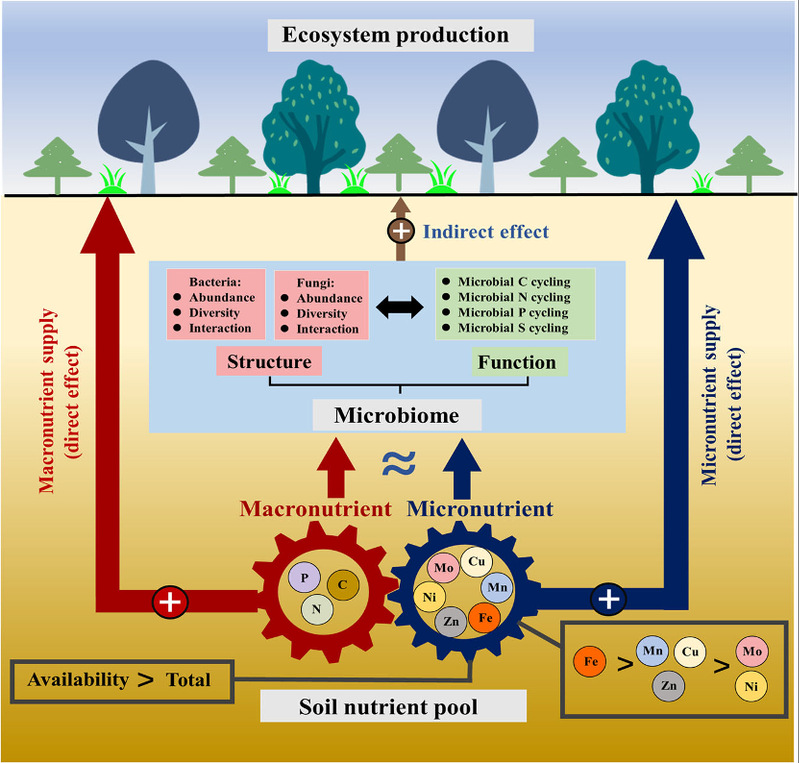Prof. Xu Jianming's team published a paper in Nature Communications revealing the association between metallic micronutrients and soil microbial structure and function
2023-12-21

Metallic micronutrients such as iron (Fe), manganese (Mn), copper (Cu), zinc (Zn), molybdenum (Mo), and nickel (Ni) are essential for the growth of living organisms despite their low content. Compared to animals and plants, metallic micronutrients also play key regulatory roles in microbial photosynthesis and respiration, biomolecular synthesis, redox homeostasis, cell growth and immune system functions.
The contribution of micronutrients to the microbiome is now well established in marine ecosystems and human gut systems. In turn, trace elements may be associated with microbial communities and functions in soil ecosystems for the following main reasons: first, soil microbial reproduction requires trace elements for most cells and enzymes associated with bioprocesses; second, variable-valent metals such as iron and manganese in soils can participate in microbial-driven elemental coupling processes and exchange electrons; and furthermore, matrices or secondary minerals that contain different types of trace elements can cause the soils to form special ecological niches that selectively colonize microorganisms.
To address the above hypotheses, Prof. Xu Jianming's team at Zhejiang University collected soils from 180 sample sites in China, and used 16S, ITS, macro-genome sequencing and high-throughput qPCR technologies, combined with culture experiments, to correlate the types and contents of trace elements with soil microbial community structure and function. It was found that trace elements and macroelements such as carbon, nitrogen and phosphorus explained the microbial communities and functions in a “cogwheel” manner. Among them, the effectiveness of elements explained the microbial community more than the total number of elements, the variable element FeMn affected the microbial community more than the non-variable elements such as CuZnMoNi, and the coexistence of multiple elements explained the microbial community more than the coexistence of a single element. Of particular note, soil pH was correlated with both microbial diversity and metal element effectiveness, and this study found a high degree of correlation between micronutrients and soil microbial abundance, diversity, and functioning even after removing soil pH disturbance.
Soil micronutrients were also found to contribute to plant productivity, but mainly from the direct supply of soil “nutrients”. Microorganisms associated with micronutrients did not explain plant productivity as well, suggesting that the contribution of micronutrients in terrestrial ecosystems cannot be arbitrarily amplified. This work emphasizes the unique associations between metallic micronutrients and soil microbial community structure and function, and future studies to explain soil microbial community structure and function will need to consider the combined contributions of soil pH, macro- and micronutrients.

Conceptual diagramillustrating the impacts of soilmicronutrients and soil macronutrient on the structure and function of soil microbiome.
The research results were recently published in Nature Communications under the title “Metallic micronutrients are associated with the structure and function of the soil microbiome”. Dr. Dai Zhongmin, Associate Researcher of Institute of New Rural Development Acadamy, Zhejiang University, was the first author, Prof. Xu Jianming of College of Environment and Resources was the corresponding author, and Zhejiang University was the first and corresponding author. Spanish soil scientists Manuel Delgado-Baquerizo and Eduardo Moreno-Jiménez participated in this research. This research was supported by the National Natural Science Foundation of China under the major project topic (41991334), the National Key Research and Development Program of China (2019YFC1803704), and the Modern Agricultural Industrial Technology System Project (CARS-01).
